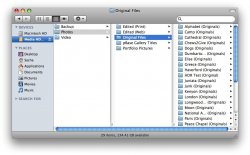I have evolved into a system similar to that of ChrisA over a period of 8 years and involving several cameras. i have used iPhoto, Canon's ImageBrowser, Nikon's PictureProject and NX, Photoshop Elements, and Aperture. All are in the latest version except iPhoto. I will itemize some of the things I think I have learned, and why.
1. I import from the camera or card to a folder that is named by date in the following format 2008-02-07. Early software brought them into a numbered folder, or whatever, and after awhile I lost track of what was in them or when they were taken. I would have to open the folder or expand the finder to know what was going on. Some software organized them month-year-date and that became a disaster for sorting in the finder. So, in my old age I use the year-month-date format and append a one-word descriptor to spark my memory, ie. 2008-02-07 Yellowstone. This naming convention is in the finder and I find it is really helpful to locate something. I typically download daily and the folder name reflects the download date and a descriptor.
2. Because the early camera systems set up their own folders, I continue to do that as a backup system. It is my form of redundancy but you may want to skip that. I have had hard drives and graphic cards go, programs and libraries get corrupted, and had to reconstruct 20K image libraries with keywords, etc. a couple times. So for me, I will continue with the redundancy in addition to the normal backup scheme. I have decided that I cannot trust PictureProject, which has my most extensive library, and therefore, I don't want to trust Aperture or anything else yet.
3. I copy that named folder (2008-02-07 Yellowstone) to another hard drive and into a folder named Aperture Image File. This is copied at the finder level. This folder holds everything that I choose to bring into Aperture as referenced images. The naming convention carries through into this Aperture Image File and that makes it easy to browse at the finder level when I want to.
4. Finally, I "import folders as projects" into Aperture, making sure they come into the blue folder named 2008 Import Folders. (If I miss, they can be moved later.) By doing the import this way, the naming convention carries over into the projects and makes then easy to get around in. The images are stored in their original position.
5.This last step takes the most discipline, and I came to it grudgingly, but I found out that that database was pretty useless unless I did it. I force myself to do keywords and at least a little bit of rating. But the keywords are vitally important. I do this and metadata such as locations, copyright, occasional comment immediately after I import to a project so I can batch apply the changes to the biggest number of pictures at a time.
I recommend starting with a smaller keyword set that is very broad, and that you can add to when or if you have to. My early set went something like family, friends, landscapes, animals, events, etc. If you start this way, you can develop a keyword scheme that works easily for you and only expand it where you need to.
To explain how this works, say you keyword all your relatives as family when they come in. Over time you realize that you have several hundred "family" images and want to break them down a little more. You could do a filter on "family" to select all those images and then tag them with additional keywords such as "me", "wife", "Kid 1", "Kid2", etc. You don't tag Uncle Benny because he is only in there twice and you can just hunt for him if you ever need him. I found over time that I needed to add surnames in the family category because I got into reconstructing old family archives. But, it was easier to add them when really needed rather than be compulsive about it at the beginning and probably never really get it done. I find that ready-made keyword sets are far too extensive for me as a hobbyist, although they are good to look at when you get into expanding what you need. No sense in having to totally reinvent the wheel.
6. Like ChrisA said, once you get to this point, it is easy to set up albums within a project, or smart albums, or temporary smart albums. He is right that no system stays static but it needs a minimal amount of work to be able to be fluid.
7. I love Aperture, especially the 2.1 version, and expect that it will do all that I will need to do for a long time. Part of loving it though was to follow others advice and think through how I wanted to use it and set up the structure to do that in advance. So far, I am very pleased that I did that and it sounds like you are asking the same kind of questions that I did. By setting up Aperture this way, it is my main program, but those redundant original folders are still available to other programs when I want to tweak something outside of Aperture.
Hope this helps. Bill




